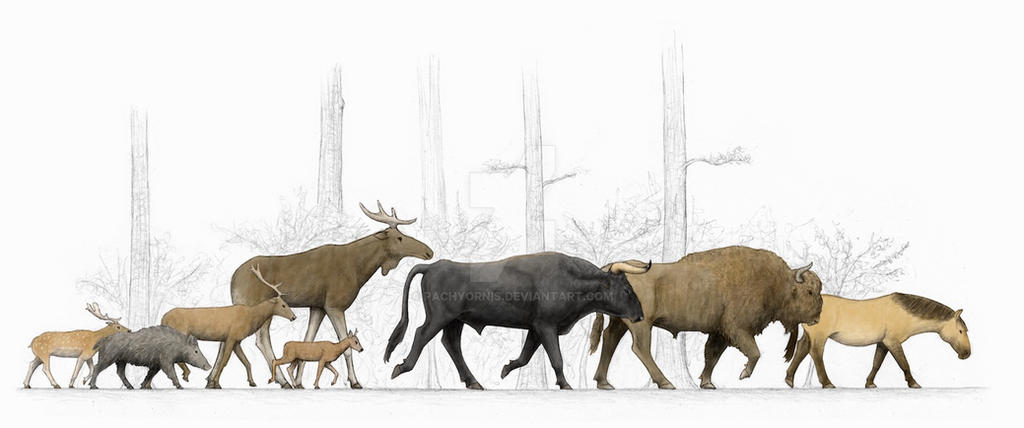I recently
did another drawing showing Holocene Europe’s megaherbivores of the nemoral
mixed-forest zonobiome, drawn to same scale. It shows, from left to right:
fallow deer, Dama dama; wild boar, Sus scrofa; red deer, Cervus elaphus; elk, Alces alces; roe deer, Capreolus capreolus;
aurochs, Bos primigenius primigenius; wisent,
Bison bonasus; European wild horse, Equus
ferus ferus.
I know of
course that wild boar are actually omnivores. One might ask why I included fallow
deer, as it was introduced in historical times just like the mufflon. In
contrast to the mufflon it has a Pleistocene interglacial record in Central
Europe, which is why I included it here. The question is whether Dama dama would have recolonized Europe without
human influence. In order to answer the inevitable question “but where are
elephants and rhinoceroses?”, my drawing intends to illustrate only those
herbivores which had a solid presence in Holocene Europe. It is not known for
certain that the European continental elephant species Palaeoloxodon antiquus as
much as the two rhino species of the genus Stephanorhinus
have been driven to extinction by men and would still be extant without
anthropogenic influence today. It is plausible, I even consider it likely, but
not proven. One might also ask where water buffalo and Equus hydruntinus, the
European wild ass, are. There is only one Holocene remain for the genus Bubalus in Europe (Austria, to be
precise) which has been tentatively assigned to this genus by Erich Pucher in
1993, nowadays he would reclassify it as Bos
(personal communication). Bubalus murrensis might have been hunted to
extinction (although its record is really rare and I do not know of literature
mentioning its association with kill sites), but here goes the same as for
elephants and rhinos. Europe being recolonized by extant members of Bubalus without anthropogenic influence
is speculation. Equus hydruntinus has a solid Holocene
evidence in Neusiedl, Austria (Pucher, pers. com.), but as part of a different
biome – the Puszta steppe.
When I
refer to a mixed-forest zonobiome I do not intend to imply it was naturally all
forested. I consider the classical hypothesis of this biome being one closed
canopy forest falsified by a number of facts. However, I also consider it an
exaggeration to speak of a European savannah, as there is also evidence
pointing against such a hypothesis. To me it is most likely that this biome was
a mosaic of open, semi-open and closed landscape, depending on a variety of
factors also including such as latitude, precipitation, flooding and humidity,
natural disasters and so on. This a complex, big and (needlessly) heated debate
that is way to extensive for this post and my drawing. I could have drawn my
megaherbivores on a grassy background, which would be only one of several
habitats we might have encountered those animals, but sporadic oak trees and
hazel bushes are certainly a realistic background as well considering they have
been pushed in those habitats as civilization progressed and the space for wild
herbivores became increasingly limited.
I decided to
give my wild horse a bay dun colouration, as bay dun is suggested to have been
most frequent in Holocene wild horses by genetic evidence. Historic evidence,
which is dubious, would have favoured black dun, but both colour variants plus
the non-dun variants are proven for ferus-type
wild horses. For details, see my wild horse summary 2017.
And here a
close-up view of the aurochs:
I am very
happy with this one, I managed to get it exactly the way I imagine Holocene
European aurochs bulls to have looked like. It is based on my reconstructions
of several skeletons that I published in July 2017 and I think it bears a striking
similarity to many Lidia bulls. I am going to post a refined version of that
close-up drawing soon.



Why do you refer to the late Pleistocene western European rhinos as Stephanochoerus? The Narrow-Lipped and Merck's rhino are in the genus Stephanorhinus.
ReplyDeleteIt was a typing mistake, thanks for pointing that out.
DeleteWell, since you consider likely, but not proven that Palaeoloxodon and Stephanorhinus went extinct by human hunting
ReplyDeleteDo you think that introducing Elephants and Rhinoceros in a closed habitat to study their impact in the ecosystem prove it?
If they turn out to be beneficial to the ecosystem, I don't see why they couldn't be introduced in some places, obviously fenced
Anyways, great post
Maybe you can add the Saiga ? Rewilding Europe seems to have a projects with this species.
ReplyDeletemaybe asiatic liosn should be rewilded back in the caucasus
ReplyDelete*lions
ReplyDelete